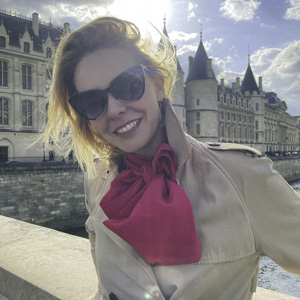
Name and Surname
Milica Božić Marojević
Affiliation
Associate Professor
Contact email
mbozic@f.bg.ac.rs
Short Biography
Milica Božić Marojević (1980) was born in Belgrade. She completed her bachelor, master and PhD studies in Art History at the Faculty of Philosophy, University of Belgrade, where at present she teaches as Associate Professor. She has also been teaching at the Faculty of Applied Arts and Faculty of Education in Belgrade, as well as at the Faculty of Philosophy in Kosovska Mitrovica. Since 2017, Milica Božić Marojević has been actively participating in the organization and implementation of the continuous learning program at the Center for Teacher Education of the Faculty of Philosophy, University of Belgrade. In 2019, she was elected as director of the Centre for Museology and Heritology. Before that, Milica Božić Marojević was a journalist at Danas Daily, Researcher at Humanitarian Law Center and an International Memorialization Specialist for UNDP Bosnia and Herzegovina.
For more than 20 years, she has been interested in the problems of heritage dissonance and reconciliation through art, culture and heritage memorialization. As a regional and international consultant for the management of unwanted heritage, she had organized and participated in various researches and trainings; programmes of permanent education and specialization; curated several exhibitions and wrote more than 30 scientific papers with the focus on the social, cultural and political implications of forgetting events from the past.
In addition to the social role of heritage, its policies, governance, presentation and interpretation, her areas of expertise are also promotion of activism and civic education. Her Ph.D. thesis “Sites of Conscience as Guardians of the Collective Memory” was the first study in the field of heritage dissonance and its role in post war reconciliation processes conducted in the region.
Her first book (Ne)željeno nasleđe u prostorima pamćenja. Slobodne zone bolnih uspomena/(Un)Wanted Heritage in Remembrence Spaces. Free Zones of Painful Memories was published in 2015, as the result of pioneering research in war heritage memorialisation in Yugoslav spaces, and is the first publication of its kind in the Serbian language. Her second book Metod kao predmet ili predmet kao metod. Poučavanje (o) umetnosti u osam koraka/Method as Subject or Subject as Method. Teaching (about) Art in Eight Steps was published in 2022 and is a summary of her years of experience in the field of education through art and culture.
Research Abstract
Back to the Future or How to Make Peace with The Past in Order to Create a Better Tomorrow Together
Public spaces and their visual culture are active participants in creating of public knowledge. That knowledge is primarily represented and recognized through monuments and/or different memorialization practices. However, how that space looks like and what politics and policies represents is never accidental. It is something that is always decided by the ruling elite. Even though that does not necessarily mean that the ruling elites are going to have a negative attitude towards the previous regime or representatives of minorities in general, in the Western Balkans region it is a rule. Changes in the domain of political climate here are very common and they can easily be traced in the public space appearance too. In those circumstances, (cultural) heritage seems to be another victim. It suffers not just for the sake of new ideology, but also in order people to forget their past. When it comes to the so-called difficult places and spaces, the situation in the domain of collective memory is even worse. It looks like we are in a vicious circle of the permanent present built on the remnants of nationalist and exclusive accounts of the past. Because of that, a progressive vision on future is missing. Silenced and marginalized memories, as well as contested histories, seem to be the dominant narratives in everyday life. The roles of certain public figures are being re-examined, the culture of cancellation is stronger; we are afraid of refugees, we blame them for diseases, the increase in unemployment, religious fanaticism. Although experts insist that culture and arts unite us, how does it happen that they actually separate us?
The basic research direction is motivated by a long-term search for an answer to the question: how can Serbs and Albanians live together again after everything that happened in Kosovo? This led to further doubts – what are our points of similarities; what kind of culture of memory do we want to cherish, whether and how heritage, that is, the past can help us in building a better future; what is the role of education in this? The focus of the research is directed at young people in Belgrade, i.e. at those who do not remember the controversial events at first hand, but formed their views about them through family stories, education, and memory policies promoted by the ruling elites. Although the problems of young people are similar in Belgrade, Kosovska Mitrovica and Priština, they do not think about how to get to know each other better and how to cooperate, or how together they can create democratic, multi-ethnic, multi-confessional, open, plural, and inclusive societies.
Considering heritage as a source for knowledge seems obvious, but the aim of this project is to invite us to question it critically. My idea is to highlight specific problematic issues, but also potentials for representation involved in such difficult heritage, and to identify and analyse ways in which they can contribute to social reflection. I would also like to inspire analytical reflection on heritage and the values and power dynamics attached to it, and to facilitate dialogue about the uses of the past in the present. Cultivating a culture based on facts is indispensable. Yet, equally important is to formulate and foster a “culture of a shared future” in the region – bringing forward narratives, evidence, and politics to replace a culture of hostility with a common vision of a joint future. In that sense, this research is part of a long-standing effort to show that heritage is here to bring us together.
